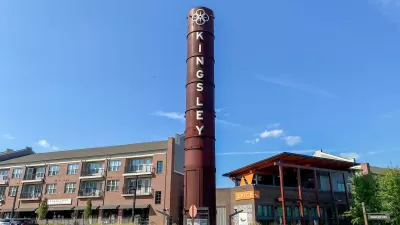Julie V. Iovine laments that while walkability is the watchword of the day, architects have to design what they're hired to design -- and that often means designing iconic buildings that turn a blind eye to pedestrians.
The principles of walkability, transit access, open space and variations in scale are key concepts to building a truly sustainable city, writes Julie V. Iovine of The Architect's Newspaper, particularly in the United States. But when American architects are contracted for work in China, Dubai and other far-flung climes, many of those ideals go out the window.
Iovine writes that the problem is especially present in the booming cities of Asia and the Middle East, where "60's-style towers-in-the-park...dressed up with some sustainable flourishes and surrounded by streaking roadways...barely addresses the street-level experience of people trying to get from."
Iovine calls on both architects and planners to work together, "as they are beginning to do so effectively here," to "espouse the same values of human scale and walkability when working abroad."
FULL STORY: Editorial> Walk the Walk

Study: Maui’s Plan to Convert Vacation Rentals to Long-Term Housing Could Cause Nearly $1 Billion Economic Loss
The plan would reduce visitor accommodation by 25,% resulting in 1,900 jobs lost.

North Texas Transit Leaders Tout Benefits of TOD for Growing Region
At a summit focused on transit-oriented development, policymakers discussed how North Texas’ expanded light rail system can serve as a tool for economic growth.

Why Should We Subsidize Public Transportation?
Many public transit agencies face financial stress due to rising costs, declining fare revenue, and declining subsidies. Transit advocates must provide a strong business case for increasing public transit funding.

How to Make US Trains Faster
Changes to boarding platforms and a switch to electric trains could improve U.S. passenger rail service without the added cost of high-speed rail.

Columbia’s Revitalized ‘Loop’ Is a Hub for Local Entrepreneurs
A focus on small businesses is helping a commercial corridor in Columbia, Missouri thrive.

Invasive Insect Threatens Minnesota’s Ash Forests
The Emerald Ash Borer is a rapidly spreading invasive pest threatening Minnesota’s ash trees, and homeowners are encouraged to plant diverse replacement species, avoid moving ash firewood, and monitor for signs of infestation.
Urban Design for Planners 1: Software Tools
This six-course series explores essential urban design concepts using open source software and equips planners with the tools they need to participate fully in the urban design process.
Planning for Universal Design
Learn the tools for implementing Universal Design in planning regulations.
City of Santa Clarita
Ascent Environmental
Institute for Housing and Urban Development Studies (IHS)
City of Grandview
Harvard GSD Executive Education
Toledo-Lucas County Plan Commissions
Salt Lake City
NYU Wagner Graduate School of Public Service




























